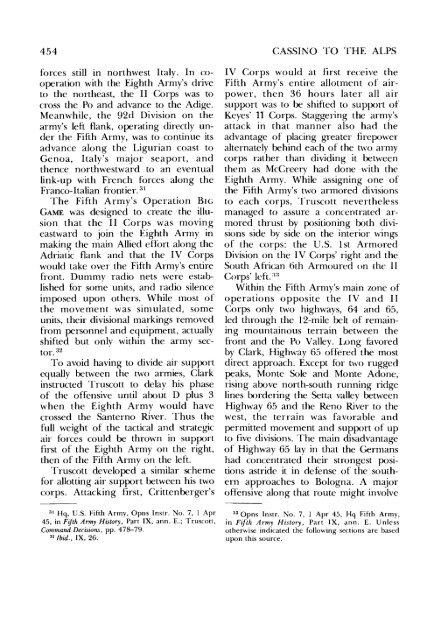Cassino to the Alps - US Army Center Of Military History
Cassino to the Alps - US Army Center Of Military History
Cassino to the Alps - US Army Center Of Military History
Create successful ePaper yourself
Turn your PDF publications into a flip-book with our unique Google optimized e-Paper software.
454<br />
forces still in northwest Italy. In cooperation<br />
with <strong>the</strong> Eighth <strong>Army</strong>'s drive<br />
<strong>to</strong> <strong>the</strong> nor<strong>the</strong>ast, <strong>the</strong> II Corps was <strong>to</strong><br />
cross <strong>the</strong> Po and advance <strong>to</strong> <strong>the</strong> Adige.<br />
Meanwhile, <strong>the</strong> 92d Division on <strong>the</strong><br />
army's left flank, operating directly under<br />
<strong>the</strong> Fifth <strong>Army</strong>, was <strong>to</strong> continue its<br />
advance along <strong>the</strong> Ligurian coast <strong>to</strong><br />
Genoa, Italy's major seaport, and<br />
<strong>the</strong>nce northwestward <strong>to</strong> an eventual<br />
link-up with French forces along <strong>the</strong><br />
Franco-Italian frontier. 31<br />
The Fifth <strong>Army</strong>'s Operation BIG<br />
GAME was designed <strong>to</strong> create <strong>the</strong> illusion<br />
that <strong>the</strong> I I Corps was moving<br />
eastward <strong>to</strong> join <strong>the</strong> Eighth <strong>Army</strong> in<br />
making <strong>the</strong> main Allied effort along <strong>the</strong><br />
Adriatic flank and that <strong>the</strong> IV Corps<br />
would take over <strong>the</strong> Fifth <strong>Army</strong>'s entire<br />
front. Dummy radio nets were established<br />
for some units, and radio silence<br />
imposed upon o<strong>the</strong>rs. While most of<br />
<strong>the</strong> movement was simulated, some<br />
units, <strong>the</strong>ir divisional markings removed<br />
from personnel and equipment, actually<br />
shifted but only within <strong>the</strong> army sec<strong>to</strong>r.<br />
32<br />
To avoid having <strong>to</strong> divide air support<br />
equally between <strong>the</strong> two armies, Clark<br />
instructed Truscott <strong>to</strong> delay his phase<br />
of <strong>the</strong> offensive until about D plus 3<br />
when <strong>the</strong> Eighth <strong>Army</strong> would have<br />
crossed <strong>the</strong> Santerno River. Thus <strong>the</strong><br />
full weight of <strong>the</strong> tactical and strategic<br />
air forces could be thrown in support<br />
first of <strong>the</strong> Eighth <strong>Army</strong> on <strong>the</strong> right,<br />
<strong>the</strong>n of <strong>the</strong> Fifth <strong>Army</strong> on <strong>the</strong> left.<br />
Truscott developed a similar scheme<br />
for allotting air support between his two<br />
corps. Attacking first, Crittenberger's<br />
31 Hq, U.S. Fifth <strong>Army</strong>, Opns lnstr. No.7, I Apr<br />
45, in Fifth <strong>Army</strong> His<strong>to</strong>ry, Part IX, ann. E.; Truscott,<br />
Command Decisions, pp. 478-79.<br />
32 Ibid., IX, 26.<br />
CASSINO TO THE ALPS<br />
IV Corps would at first receive <strong>the</strong><br />
Fifth <strong>Army</strong>'s entire allotment of airpower,<br />
<strong>the</strong>n 36 hours later all air<br />
support was <strong>to</strong> be shifted <strong>to</strong> su pport of<br />
Keyes' 11 Corps. Staggering <strong>the</strong> army's<br />
attack in that manner also had <strong>the</strong><br />
advantage of placing greater firepower<br />
alternately behind each of <strong>the</strong> two army<br />
corps ra<strong>the</strong>r than dividing it between<br />
<strong>the</strong>m as McCreery had done with <strong>the</strong><br />
Eighth <strong>Army</strong>. While assigning one of<br />
<strong>the</strong> Fifth <strong>Army</strong>'s two armored divisions<br />
<strong>to</strong> each corps, Truscott never<strong>the</strong>less<br />
managed <strong>to</strong> assure a concentrated armored<br />
thrust by positioning both divisions<br />
side by side on <strong>the</strong> interior wings<br />
of <strong>the</strong> corps: <strong>the</strong> U.S. 1st Armored<br />
Division on <strong>the</strong> I V Corps' right and <strong>the</strong><br />
South African 6th Armoured on <strong>the</strong> II<br />
Corps' left. :!;;<br />
Within <strong>the</strong> Fifth <strong>Army</strong>'s· main wne of<br />
operations opposite <strong>the</strong> IV and I I<br />
Corps only two highways, 64 and 65,<br />
led through <strong>the</strong> 12-mile belt of remaining<br />
mountainous terrain between <strong>the</strong><br />
front and <strong>the</strong> Po Valley. Long favored<br />
by Clark, Highway 65 offered <strong>the</strong> most<br />
direct approach. Except for two rugged<br />
peaks, Monte Sole and Monte Adone,<br />
rising above north-south running ridge<br />
lines bordering <strong>the</strong> Setta valley between<br />
Highway 65 and <strong>the</strong> Reno River <strong>to</strong> <strong>the</strong><br />
west, <strong>the</strong> terrain was favorable and<br />
permitted movement and support of up<br />
<strong>to</strong> five divisions. The main disadvantage<br />
of Highway 65 lay in that <strong>the</strong> Germans<br />
had concentrated <strong>the</strong>ir strongest positions<br />
astride it in defense of <strong>the</strong> sou<strong>the</strong>rn<br />
approaches <strong>to</strong> Bologna. A major<br />
offensive along that route might involve<br />
330pns Instr. No.7, I Apr 45, Hq Fifth <strong>Army</strong>,<br />
in Fifth <strong>Army</strong> His<strong>to</strong>ry, Part IX, ann. E. Unless<br />
o<strong>the</strong>rwise indicated <strong>the</strong> following sections are based<br />
upon this source.
















